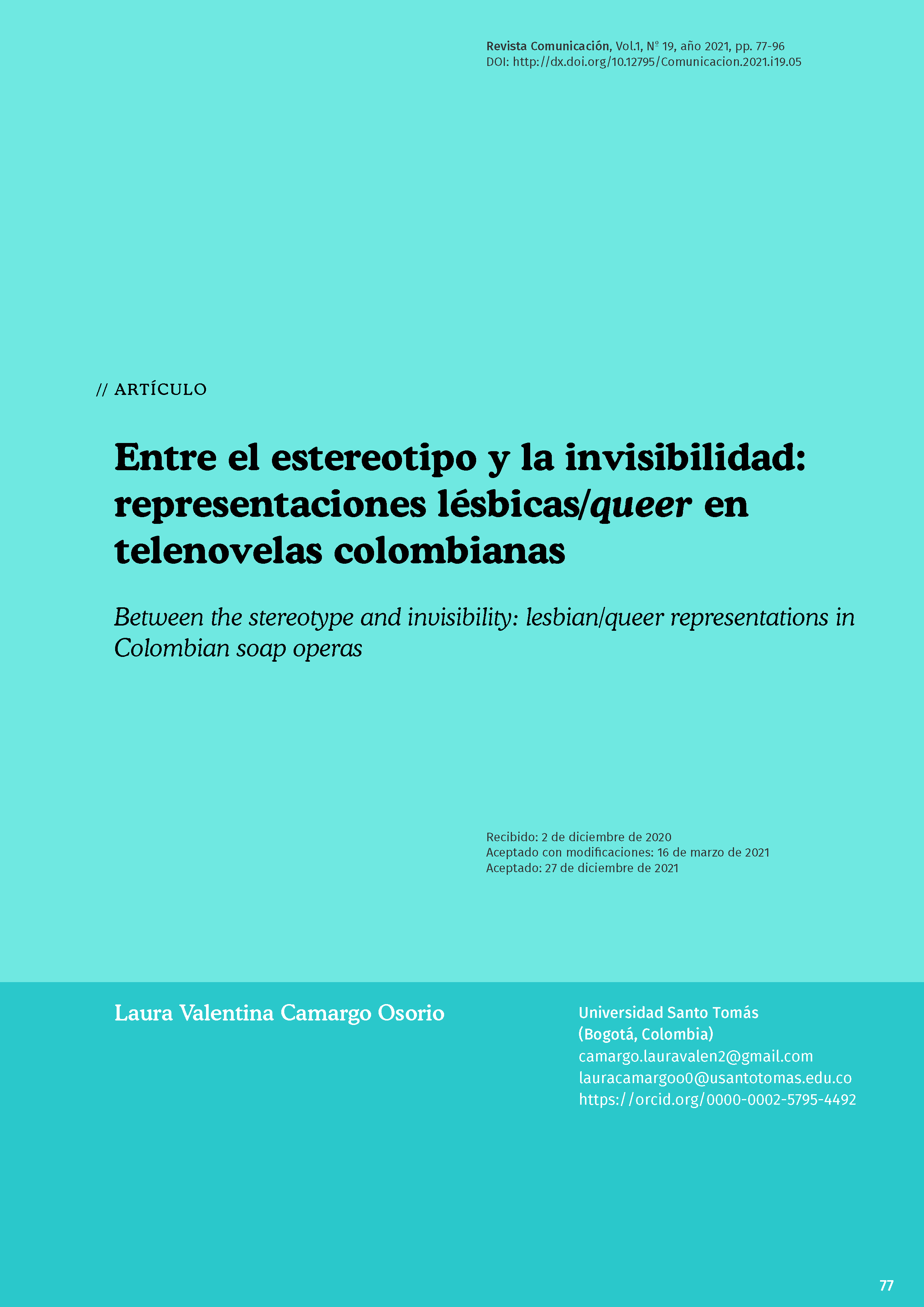Abstract
This article is a product of my process and training as a young researcher at the Santo Tomás University, Bogotá, Colombia, 2020, tied to the project titled Fashion Studies in Colombia, led by Professor Edward Salazar. Within this context, I analyze the aesthetics and representations of lesbian / queer women in some Colombian audiovisual products, particularly in telenovelas. Under a qualitative methodology I analyze the lesbian / queer representation in latin american melodramatic mass media. Specifically, the way they are represented in four Colombian telenovelas and within them what kind of plots and stereotypes these productions have in common, how the concept of passing, censorship, and the type of actresses who are chosen for these roles, in order to better understand the country's context around audiovisual and queer culture, and how representations affect and have affected society in all areas; political, economic, cultural, etc. Throughout the research it becomes evident that in Colombia, there is a significant connection between the type of lesbian representation in the media, and the way in which the lesbian community and queer women as a whole are culturally perceived as liking other women.
References
Alcaldía Mayor de Bogotá (2008). “Estado del arte sobre las prácticas culturales de la población LGBT en Bogotá, D. C.”. Bogotá D.C.
Bain, Alison L.; Podmore, Julie A., y Rosenberg, Rae (2020). “‘Straightening’ space and time? Peripheral moral panics in print media representations of Canadian LGBTQ2S suburbanites, 1985–2005”, Social & Cultural Geography, 21:6, 839-861, doi: https://doi.org/10.1080/14649365.2018.1528629
Bourdieu, Pierre (1998). La distinción. Criterios y bases sociales del buen gusto. Madrid: Taurus.
Cabrera, Marta, y Gómez, Marcela (2014). “Documentos efímeros, o cómo dar cuenta de existencias visibles: pensando un archivo lésbico para Bogotá”, resultado del simposio En Torno Al Documento Colombia Diversa, 2015. Situación de derechos humanos de las personas LGBT en Colombia, 2010-2015.
El Espectador (2014). “Los pecados de Inés de Hinojosa” vuelve a la televisión nacional. El Espectador, 11 de octubre. Disponible en https://www.elespectador.com/entretenimiento/cine-y-tv/los-pecados-de-ines-de-hinojosa-vuelve-a-la-television-nacional-article-521609
Entman, Robert (1993). “Framing: Toward clarification of a fractured paradigm”. Journal of Communication, 43, 51–58.
Esguerra Muelle, Camila (2002). “Del pecatum mutum al orgullo de ser lesbiana. Grupo Triángulo Negro de Bogotá (1996 - 1999)”. Tesis para optar por el grado de antropóloga. Universidad Nacional de Colombia.
Garber, Marjorie (2012). Vested Interests. Hoboken: Taylor and Francis.
Garibaldi, Ana María (2019). “Sobre el efecto especular. Algunos alcances de su análisis en la convivencia social.” XI Congreso Internacional de Investigación y Práctica Profesional en Psicología. XXVI Jornadas de Investigación. XV Encuentro de Investigadores en Psicología del MERCOSUR. I Encuentro de Investigación de Terapia Ocupacional. I Encuentro de Musicoterapia. Facultad de Psicología - Universidad de Buenos Aires, Buenos Aires.
Gimeno Reinoso, Beatriz, y Barrientos Silva, Violeta (2009). “Violencia de género versus violencia doméstica: La importancia de la especificidad”. Revista Venezolana de Estudios de la Mujer, 14(32), 27-42.
Goffman, Erving (1974). Frame analysis: An essay on the organization of experience. London: Harper and Row.
Gómez Serrudo, Nelson, y Bello León, Eliana (2016). “Las polémicas de la censura: Arte, entretenimiento y educación” . En Gómez Serrudo, Nelson, y Bello León, Eliana, La vida del cine en Bogotá en el siglo XX: Públicos y sociabilidad (pp. 65-82). Bogotá: Pontificia Universidad Javeriana.
Halberstam, Judith (1998). Female Masculinity. Duke University Press.
Marhoefer, Laurie (2015). “’The Book Was a Revelation, I Recognized Myself in it’: Lesbian Sexuality, Censorship, and the Queer Press in Weimar-era Germany”. Journal of Women’s History, 27:2, pp. 62-86. DOI: 10.1353/jowh.2015.0016.
Martín-Barbero, Jesús, y Muñoz, Sònia, 1992. Televisión y melodrama Géneros y lecturas de la televisión en Colombia. Tercer Mundo Editores.
Nasio, J.-D. (2012). ¿Cómo actuar con un adolescente dificil? Consejos para padres y
profesionales. Buenos Aires: Paidós.
Oliver, Kelly (2017). “The male gaze is more relevant, and more dangerous, than ever”. New Review of Film and Television Studies, 15:4, 451-455, doi: https://doi.org/10.1080/17400309.2017.1377937
Redacción El Tiempo, 1997. RETIRAN PAUTA DE PERFUME DE AGONÍA. El Tiempo, 15 de mayo. Disponible en https://www.eltiempo.com/archivo/documento/MAM-570989
Samuels, Ellen (2015). “Passing”. In Adams R., Reiss B., y Serlin D. (Eds.), Keywords for Disability Studies (pp. 135-137). NYU Press.

This work is licensed under a Creative Commons Attribution-NonCommercial-ShareAlike 4.0 International License.
Copyright (c) 2021 Laura Valentina Camargo Osorio

